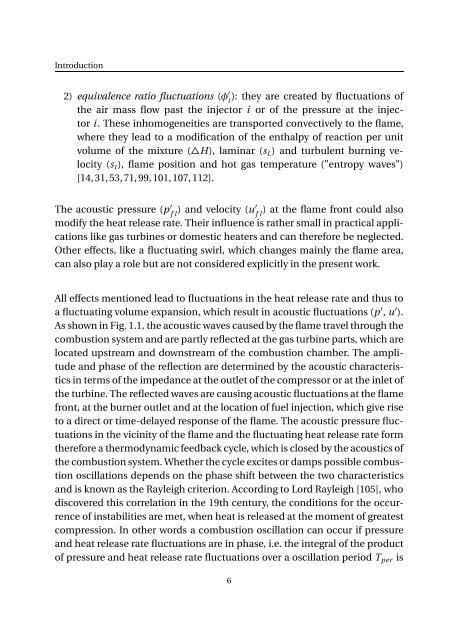Impact of fuel supply impedance and fuel staging on gas turbine ...
Impact of fuel supply impedance and fuel staging on gas turbine ...
Impact of fuel supply impedance and fuel staging on gas turbine ...
Create successful ePaper yourself
Turn your PDF publications into a flip-book with our unique Google optimized e-Paper software.
Introducti<strong>on</strong><br />
2) equivalence ratio fluctuati<strong>on</strong>s (φ ′ i<br />
): they are created by fluctuati<strong>on</strong>s <str<strong>on</strong>g>of</str<strong>on</strong>g><br />
the air mass flow past the injector i or <str<strong>on</strong>g>of</str<strong>on</strong>g> the pressure at the injector<br />
i . These inhomogeneities are transported c<strong>on</strong>vectively to the flame,<br />
where they lead to a modificati<strong>on</strong> <str<strong>on</strong>g>of</str<strong>on</strong>g> the enthalpy <str<strong>on</strong>g>of</str<strong>on</strong>g> reacti<strong>on</strong> per unit<br />
volume <str<strong>on</strong>g>of</str<strong>on</strong>g> the mixture (△H), laminar (s L ) <str<strong>on</strong>g>and</str<strong>on</strong>g> turbulent burning velocity<br />
(s t ), flame positi<strong>on</strong> <str<strong>on</strong>g>and</str<strong>on</strong>g> hot <strong>gas</strong> temperature (”entropy waves”)<br />
[14, 31, 53, 71, 99, 101, 107, 112].<br />
The acoustic pressure (p ′ f l ) <str<strong>on</strong>g>and</str<strong>on</strong>g> velocity (u′ ) at the flame fr<strong>on</strong>t could also<br />
f l<br />
modify the heat release rate. Their influence is rather small in practical applicati<strong>on</strong>s<br />
like <strong>gas</strong> <strong>turbine</strong>s or domestic heaters <str<strong>on</strong>g>and</str<strong>on</strong>g> can therefore be neglected.<br />
Other effects, like a fluctuating swirl, which changes mainly the flame area,<br />
can also play a role but are not c<strong>on</strong>sidered explicitly in the present work.<br />
All effects menti<strong>on</strong>ed lead to fluctuati<strong>on</strong>s in the heat release rate <str<strong>on</strong>g>and</str<strong>on</strong>g> thus to<br />
a fluctuating volume expansi<strong>on</strong>, which result in acoustic fluctuati<strong>on</strong>s (p ′ , u ′ ).<br />
As shown in Fig. 1.1, the acoustic waves caused by the flame travel through the<br />
combusti<strong>on</strong> system <str<strong>on</strong>g>and</str<strong>on</strong>g> are partly reflected at the <strong>gas</strong> <strong>turbine</strong> parts, which are<br />
located upstream <str<strong>on</strong>g>and</str<strong>on</strong>g> downstream <str<strong>on</strong>g>of</str<strong>on</strong>g> the combusti<strong>on</strong> chamber. The amplitude<br />
<str<strong>on</strong>g>and</str<strong>on</strong>g> phase <str<strong>on</strong>g>of</str<strong>on</strong>g> the reflecti<strong>on</strong> are determined by the acoustic characteristics<br />
in terms <str<strong>on</strong>g>of</str<strong>on</strong>g> the <str<strong>on</strong>g>impedance</str<strong>on</strong>g> at the outlet <str<strong>on</strong>g>of</str<strong>on</strong>g> the compressor or at the inlet <str<strong>on</strong>g>of</str<strong>on</strong>g><br />
the <strong>turbine</strong>. The reflected waves are causing acoustic fluctuati<strong>on</strong>s at the flame<br />
fr<strong>on</strong>t, at the burner outlet <str<strong>on</strong>g>and</str<strong>on</strong>g> at the locati<strong>on</strong> <str<strong>on</strong>g>of</str<strong>on</strong>g> <str<strong>on</strong>g>fuel</str<strong>on</strong>g> injecti<strong>on</strong>, which give rise<br />
to a direct or time-delayed resp<strong>on</strong>se <str<strong>on</strong>g>of</str<strong>on</strong>g> the flame. The acoustic pressure fluctuati<strong>on</strong>s<br />
in the vicinity <str<strong>on</strong>g>of</str<strong>on</strong>g> the flame <str<strong>on</strong>g>and</str<strong>on</strong>g> the fluctuating heat release rate form<br />
therefore a thermodynamic feedback cycle, which is closed by the acoustics <str<strong>on</strong>g>of</str<strong>on</strong>g><br />
the combusti<strong>on</strong> system. Whether the cycle excites or damps possible combusti<strong>on</strong><br />
oscillati<strong>on</strong>s depends <strong>on</strong> the phase shift between the two characteristics<br />
<str<strong>on</strong>g>and</str<strong>on</strong>g> is known as the Rayleigh criteri<strong>on</strong>. According to Lord Rayleigh [105], who<br />
discovered this correlati<strong>on</strong> in the 19th century, the c<strong>on</strong>diti<strong>on</strong>s for the occurrence<br />
<str<strong>on</strong>g>of</str<strong>on</strong>g> instabilities are met, when heat is released at the moment <str<strong>on</strong>g>of</str<strong>on</strong>g> greatest<br />
compressi<strong>on</strong>. In other words a combusti<strong>on</strong> oscillati<strong>on</strong> can occur if pressure<br />
<str<strong>on</strong>g>and</str<strong>on</strong>g> heat release rate fluctuati<strong>on</strong>s are in phase, i.e. the integral <str<strong>on</strong>g>of</str<strong>on</strong>g> the product<br />
<str<strong>on</strong>g>of</str<strong>on</strong>g> pressure <str<strong>on</strong>g>and</str<strong>on</strong>g> heat release rate fluctuati<strong>on</strong>s over a oscillati<strong>on</strong> period T per is<br />
6
















